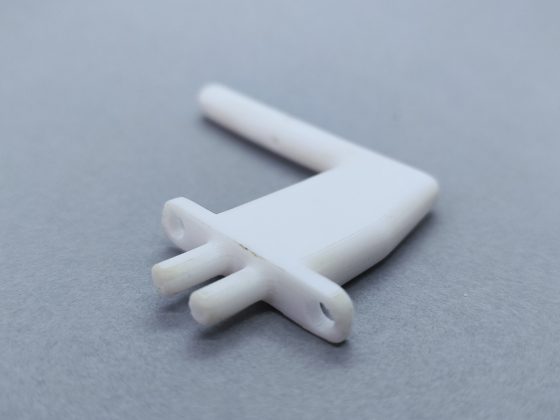
Avignon Ceramic produces ceramic parts for foundry, aerospace and energy industries. The company is historically an expert on ceramic injection molding and produces state-of the art parts such as aerospace cores. For 3 years, Avignon Ceramic has been printing parts thanks to SLA 3D printing and Zetamix .
Probes are massively used in aerospace to quantify the speed of plane. Thanks to five bent internal channels, the probe measure the dynamic and static pressure. Then, a captor measures the gap between both pressures and deducts the speed of the fluid. Usually, these probes are made either on metal and therefore do not allow the measurement of fluids in extreme environment. Probes can adopt a wide range of design depending on the use, but the internal channels are a crucial aspect that cannot be changed
picture below : Probes printed by Avignon ceramic
Avignon Ceramic produced new probes able to measure the air speed in high velocity and high temperature environment. Unlike metal probes, such parts can withstand over 2000°C and supersonic flow as well as extreme thermal shocks.. One of the best candidate material for this kind of application is alumina.
Avignon ceramics decided to produce this probes by ceramic 3D printing process. Indeed, ceramics 3D printing is the only shaping process that enable the production of complex ceramic parts with internal channel. To fully exploit additive manufacturing performance, the company decides to print the part thanks to two technologies : Zetamix and SLA.
Then, SLA is without any doubt more precise and allow to get a part with an excellent surface condition. The holes printed with SLA are also beneficing a higher resolution than the one printed with Zetamix.
However, Zetamix technology allows to print hollow out parts and honey comb structure that cannot be obtained by other process, even SLA. Printing this kind of internal structuration bring several advantages that must be considered. First, honey comb structure allow to save matter -less filament are used than with a full bodied structure. Second, this design reduce the weight of the part, that is crucial in cutting edge technology such as aerospace. Above all, honey comb structure makes the part more resistant to thermal shocks which frequently occurred in a plane engine. Furthermore, producing thick side can be really tricky in ceramic 3D printing because they can bend and break during the debinding and sintering processes. Printing honey comb side make possible to avoid this constraint and print bigger part.

Because these parts not only have to be in ceramic but also have to be equipped with internal channel it is impossible to produce with regular processes than 3D printing. By choosing Zetamix technology, Avignon Ceramic insures to produce part with excellent mechanical property thanks to the incredible variety of internal structures that can be printed.